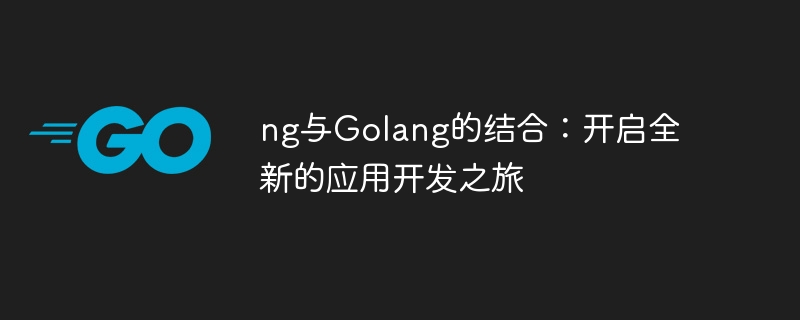ng與Golang的結合:開啟全新的應用程式開發之旅

Ng與Golang的結合:開啟全新的應用開發之旅
在當今快速發展的科技領域,全端開發已成為許多開發者追求的目標。而結合前端框架Angular(簡稱Ng)和後端語言Golang進行開發,不僅能提高開發效率,還能獲得更好的效能和使用者體驗。本文將介紹如何結合Ng和Golang進行應用程式開發,並附上具體的程式碼範例,讓讀者更能理解和運用這兩種技術。
一、Ng與Golang搭配的優勢
- Ng作為一款流行的前端框架,具有豐富的元件庫、響應式設計和強大的資料綁定能力,能夠幫助開發者快速建立現代化的使用者介面。
- Golang則是一種快速、高效的後端程式語言,具有優秀的並發處理能力和高效能,適合用於開發高並發的後端服務。
- 結合Ng和Golang可以實現前後端分離,架構清晰,便於團隊協作,同時也能提升開發效率和程式碼品質。
- Ng和Golang都擁有良好的社群支援和文件資源,學習成本低,適合新手和有經驗的開發者。
二、具體的應用程式開發範例
下面以一個簡單的部落格應用為例,示範如何結合Ng和Golang進行開發。
- 前端部分:
在Ng專案中建立一個名為blog的元件用於顯示部落格文章列表,並使用Ng的HTTP模組發送請求獲取後端數據。
import { Component, OnInit } from '@angular/core';
import { HttpClient } 從 '@angular/common/http';
@Component({
selector: 'app-blog',
templateUrl: './blog.component.html',
styleUrls: ['./blog.component.css']
})
export class BlogComponent implements OnInit {
blogs: any[];
constructor(private http: HttpClient) { }
ngOnInit(): void {
this.http.get('http://localhost:8080/api/blogs')
.subscribe((data: any) => {
this.blogs = data;
});
}
}- 後端部分:
使用Golang寫一個簡單的HTTP服務,提供RESTful API用於取得部落格文章資料。
package main
import (
"encoding/json"
"net/http"
)
type Blog struct {
ID int `json:"id"`
Title string `json:"title"`
Body string `json:"body"`
}
func main() {
blogs := []Blog{
{ID: 1, Title: "Hello, Ng and Golang", Body: "This is a blog post about Ng and Golang."},
{ID: 2, Title: "Building Modern Web Apps", Body: "Learn how to build modern web apps with Ng and Golang."},
}
http.HandleFunc("/api/blogs", func(w http.ResponseWriter, r *http.Request) {
w.Header().Set("Content-Type", "application/json")
json.NewEncoder(w).Encode(blogs)
})
http.ListenAndServe(":8080", nil)
}透過上述範例,可以看到前端部分使用Ng傳送HTTP請求取得後端數據,後端部分使用Golang提供RESTful API傳回JSON格式的部落格文章資料。結合Ng和Golang,完成了一個簡單的部落格應用程式的開發過程。
三、結語
Ng與Golang的結合開啟了全新的應用程式開發之旅,透過前後端分離、清晰的架構和高效的開發方式,開發者可以更快地建構出現代化、高效能的應用。希望透過本文的介紹和範例,讀者可以對Ng和Golang結合開發有更深入的了解,並嘗試運用到自己的專案中。祝福各位開發者在這條全新的開發之路上取得更多的成功!
以上是ng與Golang的結合:開啟全新的應用程式開發之旅的詳細內容。更多資訊請關注PHP中文網其他相關文章!

熱AI工具

Undresser.AI Undress
人工智慧驅動的應用程序,用於創建逼真的裸體照片

AI Clothes Remover
用於從照片中去除衣服的線上人工智慧工具。

Undress AI Tool
免費脫衣圖片

Clothoff.io
AI脫衣器

AI Hentai Generator
免費產生 AI 無盡。

熱門文章

熱工具

記事本++7.3.1
好用且免費的程式碼編輯器

SublimeText3漢化版
中文版,非常好用

禪工作室 13.0.1
強大的PHP整合開發環境

Dreamweaver CS6
視覺化網頁開發工具

SublimeText3 Mac版
神級程式碼編輯軟體(SublimeText3)

熱門話題
 Debian OpenSSL有哪些漏洞
Apr 02, 2025 am 07:30 AM
Debian OpenSSL有哪些漏洞
Apr 02, 2025 am 07:30 AM
OpenSSL,作為廣泛應用於安全通信的開源庫,提供了加密算法、密鑰和證書管理等功能。然而,其歷史版本中存在一些已知安全漏洞,其中一些危害極大。本文將重點介紹Debian系統中OpenSSL的常見漏洞及應對措施。 DebianOpenSSL已知漏洞:OpenSSL曾出現過多個嚴重漏洞,例如:心臟出血漏洞(CVE-2014-0160):該漏洞影響OpenSSL1.0.1至1.0.1f以及1.0.2至1.0.2beta版本。攻擊者可利用此漏洞未經授權讀取服務器上的敏感信息,包括加密密鑰等。
 Go的爬蟲Colly中Queue線程的問題是什麼?
Apr 02, 2025 pm 02:09 PM
Go的爬蟲Colly中Queue線程的問題是什麼?
Apr 02, 2025 pm 02:09 PM
Go爬蟲Colly中的Queue線程問題探討在使用Go語言的Colly爬蟲庫時,開發者常常會遇到關於線程和請求隊列的問題。 �...
 Go語言中用於浮點數運算的庫有哪些?
Apr 02, 2025 pm 02:06 PM
Go語言中用於浮點數運算的庫有哪些?
Apr 02, 2025 pm 02:06 PM
Go語言中用於浮點數運算的庫介紹在Go語言(也稱為Golang)中,進行浮點數的加減乘除運算時,如何確保精度是�...
 從前端轉型後端開發,學習Java還是Golang更有前景?
Apr 02, 2025 am 09:12 AM
從前端轉型後端開發,學習Java還是Golang更有前景?
Apr 02, 2025 am 09:12 AM
後端學習路徑:從前端轉型到後端的探索之旅作為一名從前端開發轉型的後端初學者,你已經有了nodejs的基礎,...
 您如何在go.mod文件中指定依賴項?
Mar 27, 2025 pm 07:14 PM
您如何在go.mod文件中指定依賴項?
Mar 27, 2025 pm 07:14 PM
本文討論了通過go.mod,涵蓋規範,更新和衝突解決方案管理GO模塊依賴關係。它強調了最佳實踐,例如語義版本控制和定期更新。
 Debian下PostgreSQL監控方法
Apr 02, 2025 am 07:27 AM
Debian下PostgreSQL監控方法
Apr 02, 2025 am 07:27 AM
本文介紹在Debian系統下監控PostgreSQL數據庫的多種方法和工具,助您全面掌握數據庫性能監控。一、利用PostgreSQL內置監控視圖PostgreSQL自身提供多個視圖用於監控數據庫活動:pg_stat_activity:實時展現數據庫活動,包括連接、查詢和事務等信息。 pg_stat_replication:監控複製狀態,尤其適用於流複製集群。 pg_stat_database:提供數據庫統計信息,例如數據庫大小、事務提交/回滾次數等關鍵指標。二、借助日誌分析工具pgBadg








